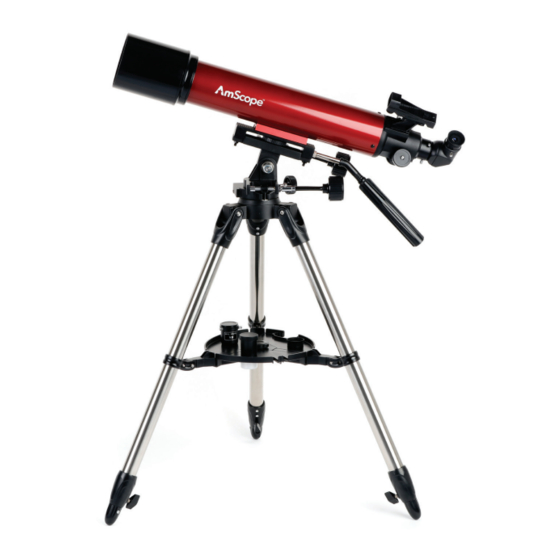AmScope TLS-T70900 Manual de instrucciones - Página 10
Navegue en línea o descargue pdf Manual de instrucciones para Telescopio AmScope TLS-T70900. AmScope TLS-T70900 17 páginas.

12. TIP'S
Picking a place to observe
Where you place your telescope when observing is dependent upon your
unique situation, but if you have a choice, follow these suggestions:
•
Find a level or near level spot.
•
Choose grass or dirt whenever possible.
•
Stay away from decks or other elevated surfaces. They vibrate when
you walk on them and will shake your telescope and therefore, the
image.
•
Never look across or over objects that are producing heatwaves. This
includes asphalt parking lots on hot summer days or building rooftops.
It will take a while before the surface stops radiating heat, which
distorts the air and therefore, the image.
•
Try to stay away from sources of light. Turn off your porch lights, and
if you are friendly with your neighbors, ask them to turn theirs off as
well.
•
Pick a location with the widest view of the sky you can find. In wooded
areas and those with lots of tall buildings, this can be a challenge.
General Observing
When working with a telescope, there are a few things to remember to ensure
you get the best possible image.
•
Never look through window glass. Glass found in household windows
is optically imperfect, and as a result, may vary in thickness from one
part of a window to the next. This inconsistency can and will affect
the ability to focus your telescope. In most cases, you will not be able
to achieve a truly sharp image, while in some cases you may see a
double image. An open window can be even worse, because warmer
indoor air will escape out the window, causing turbulence which also
affects images. Astronomy is an outdoor activity.
•
If you wear corrective lenses (specifically glasses), you may want to
remove them when observing with an eyepiece attached to the
17
amscope.com
telescope. When using a camera, however, you should always wear
corrective lenses to ensure the sharpest possible focus. If you have
astigmatism, corrective lenses must be worn at all times.
Weather conditions
You will be amazed at how quickly seeing conditions change, and what
effect they have on observations! The sky may be clear, but seeing can be
so bad that Jupiter or Saturn might look like they are underwater, and even
low magnification views are not in focus. The next night (or the next hour!)
those same planets will look perfectly focused in your highest magnification
eyepiece and all because the seeing conditions improved.
Before you set up your telescope for a night of observing, get in the habit of
taking a few moments to look up and check the conditions:
•
Are the skies clear or are there passing clouds? Knowing there are
clouds in the area helps you understand why an object you are gazing
at suddenly disappears.
•
Hazy skies, fog, and mist can also make it difficult to focus when
viewing terrestrially. The amount of detail seen under these conditions
is greatly reduced. Also, when photographing under these conditions,
the processed film may come out a little grainier than normal with
lower contrast and underexposed.
•
Are the stars twinkling? If so, are they steady overhead, or do they
twinkle from horizon to horizon? Most of the time, stars overhead are
steady, and the twinkling increases as you move towards the horizon
due to the increased atmosphere. If stars are twinkling overhead, you
have "poor seeing", but if they are steady almost to the horizon, then
grab your scope and get set up, because the seeing is especially
good, and who knows how long it will last!
•
Is it windy? A slight breeze can help keep dew at bay, but too much
wind can degrade seeing conditions and make observing
uncomfortable.
•
Is it especially humid out? Is dew already forming on surfaces? Dew
is not a deal-breaker unless it gets so heavy that all of your optics are
affected.
18
amscope.com
